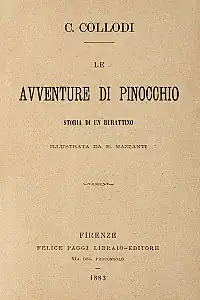| Florentine | |
|---|---|
| dialetto fiorentino | |
 The title page of Pinocchio (1883), by Carlo Collodi. Collodi included several Florentinisms in his book. | |
| Native to | Italy |
| Region | Tuscany (Florence) |
| Language codes | |
| ISO 639-3 | – |
| Glottolog | fior1235 |
| IETF | it-u-sd-itfi |
The Florentine dialect or vernacular (dialetto fiorentino or vernacolo fiorentino) is a variety of Tuscan, a Romance language spoken in the Italian city of Florence and its immediate surroundings.
A received pedagogical variant derived from it historically, once called la pronuncia fiorentina emendata (literally, 'the amended Florentine pronunciation'), was officially prescribed as the national language of the Kingdom of Italy, when it was established in 1861.
Literature
Important writers such as Dante Alighieri, Francesco Petrarch, Giovanni Boccaccio and, later, Niccolò Machiavelli and Francesco Guicciardini wrote in literary Tuscan/Florentine, perhaps the best-known example being Dante's Divine Comedy.
Differences from Standard Italian
Florentine, and Tuscan more generally, can be distinguished from Standard Italian by differences in numerous features at all levels: phonology, morphology, syntax and lexicon.
Perhaps the difference most noticed by Italians and foreigners alike is known as the gorgia toscana (literally 'Tuscan throat'), a consonant-weakening rule widespread in Tuscany in which the voiceless plosive phonemes /k/, /t/, /p/ are pronounced between vowels as fricatives [h], [θ], [ɸ] respectively. The sequence /la kasa/ la casa 'the house', for example, is pronounced [la ˈhaːsa], and /buko/ buco 'hole' is realized as [ˈbuːho]. Preceded by a pause or a consonant, /k/ is produced as [k] (as in the word casa alone or in the phrase in casa). Similar alternations obtain for /t/ → [t],[θ] and /p/ → [p],[ɸ].
Strengthening to a geminate consonant occurs when the preceding word triggers syntactic doubling (raddoppiamento fonosintattico) so the initial consonant /p/ of pipa 'pipe (for smoking)' has three phonetic forms: [p] in [ˈpiːɸa] spoken as a single word or following a consonant, [ɸ] if preceded by a vowel as in [la ɸiːɸa] la pipa 'the pipe' and [pp] (also transcribed [pː]) in [tre pˈpiːɸe] tre pipe 'three pipes'.
Parallel alternations of the affricates /tʃ/ and /dʒ/ are also typical of Florentine but by no means confined to it or even to Tuscan. The word gelato is pronounced with [dʒ] following a pause or a consonant, [ʒ] following a vowel and [ddʒ] if raddoppiamento applies ([dʒeˈlaːθo], [un dʒeˈlaːθo] un gelato, [ˈkwattro ʒeˈlaːθi] quattro gelati, [ˈtre ddʒeˈlaːθi] tre gelati. Similarly, the initial consonant of /ˈtʃena/ cena 'dinner' has three phonetic forms, [tʃ], [ʃ] and [ttʃ]. In both cases, the weakest variant appears between vowels ([reˈʒoːne] regione 'region', [ˈkwattro ʒeˈlaːθi] quattro gelati; [la ˈʃeːna] la cena, [ˈbaːʃo] bacio 'kiss').
Examples: (Florentine dialect, standard Italian, English):
- Io sòn = io sono = I am
- Te tu sei = tu sei = you are
- Egli l'è = egli è = he/she/it is
- Noi s'è/semo = noi siamo = we are
- Voi vù siete = voi siete = you are
- Essi l'enno = essi sono = they are
- Io c'ho = io ho = I have
- Te tu c'hai = tu hai = you have
- Egli c'ha = egli ha = he/she/it has
- Noi ci s'ha = noi abbiamo = we have
- Voi vù c'avete = voi avete = you have
- Essi c'hanno = essi hanno = they have
Source:[1]
References
- ↑ Vohabolario del vernaholo fiorentino e del dialetto toscano di ieri e di oggi, Romano Editore, 2009.
- Cory Crawford. "A Brief History of the Italian Language". Retrieved 2007-01-15.
- Giacomelli, Gabriella. 1975. Dialettologia toscana. Archivio glottologico italiano 60, pp. 179-191.
- Giannelli, Luciano. 2000. Toscana. (Profilo dei dialetti italiani, 9). Pisa: Pacini.